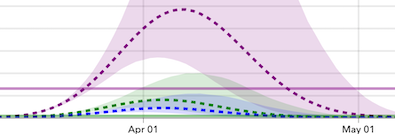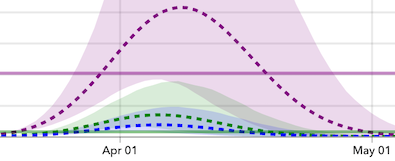* From Gov. Pritzker’s press conference…
Even though we’ve moved past the point of pure containment, it remains a priority to further build our testing abilities in part to understand the presence and spread of COVID 19 across the state. In our last testing announcement on the 24th, we were running about 2000 tests per day across our three state labs, our four commercial labs and our 15 hospital labs. Today we’re now averaging around 4000 tests per day. And in total we have now run nearly 28,000 tests here in Illinois with 30 Hospital and clinical laboratories now up and running.
Within the next 10 days we believe that we will be up to 10,000 tests per day. Again, we’re at 4000 today. That marker 10,000 is significant because it’s the number of tests per day that the scientists and experts tell us that we need to get a truly holistic understanding of the virus in each of our hundred and two counties.
Right now we’re working with roughly the same data that the majority of states are working with. That gives our state a rough picture of the viruses landscape across our state and in our municipalities by extrapolating the data using modeling largely based on the viruses spread in other countries. This 10,000 a day marker will give us the data to run a more mathematically significant model that offers us improved insight into how well our interventions are working. Ultimately, my goal is to reach a large enough testing capacity, where we’re able to test. Everyone who needs a test on a regular basis. But for right now all of the experts point to 10,000 tests as the standard that we need to achieve again.
Again, I want to be frank with you, where we are now is not where I want to be. Every day we aren’t hitting 10,000 tests or more is another day that we’re not able to get answers that help us get past this current crisis.
And to be clear though, loss of essentially the entire month of February in the effort to scale up robust testing, and the exponential spread that followed, was a profound failing of the federal government. State leaders have spent every day since then, trying to correct for this foundational mistake.
Nationally, there have been some improvements in testing, but we still have so far to go. The United States is still trailing other countries in testing on a per capita basis, several times over. In all the states we are working to fill the gap.
But the most frustrating part of this gap is, it’s not just in the past. The White House has promised millions of tests for weeks now and they’re just not here. To be clear, I also welcome the testing capacity when it actually arrives, but I’m not going to wait on promises from the federal government that may never be fulfilled. We need this testing capacity now, so we’re building it ourselves in Illinois.
Here’s how we’re getting there. All three of our state labs are running a second shift of technicians to run samples, and we’ll be adding a third shift when we can get our hands on an even larger supply of the reagent and viral transport media, and other material elements needed beyond the swabs themselves.
Second, and this is key, we’re acquiring additional laboratory robotics to load our 12 real time PCR machines at a multi thousand unit increase in single day capacity. We’re getting our first two machines on loan. And we’ll have them up and running by Tuesday, and we expect the others later this week. This technology is crucial, as it replaces manual loading and shrinks down the bottleneck for results. We’re working with the University of Illinois discovery partners Institute to ensure our staffing and logistics reflects this increased capacity, as well as exploring options with the Illinois State Police to utilize their manpower to move materials and equipment to maximize daily capacity at each of our three state labs.
You also might have heard that Friday, Abbott Laboratories, an Illinois company announced a portable five minute rapid test for COVID 19. That same night I picked up the phone and I spoke with the president of Abbott, and the CEO of Abbott separately to ask that Illinois be first in line. I’m proud to say that they expressed their real dedication to taking care of their home state, and will be very helpful to us here in Illinois as their production ramps up. In a parallel effort, we’re collaborating with our university and hospital partners to ensure Illinois’ commercial testing can grow as fast as possible.
As for our drive-thru testing, we’ve added a fifth facility since our last testing update the Illinois National Guard, really truly an amazing group, the Illinois National Guard has opened up a second state run drive thru testing facility in McLean county yesterday, joining our Harwood heights community based testing site in northwest Chicago, and the three federal HHS sites in Bolingbrook North Lake and Joliet. Our state run sites have been a huge success. And in addition to our McLean county site. We’re investigating additional areas around the state to launch potential drive thru locations symptomatic first responders healthcare workers seniors and all people with underlying health conditions will be able to visit these sites.
* Federal red tape and delays…
Still, due to the federal government requiring federal personnel representation at our two state drive throughs we remain tied to a 250 test cap at each of these locations. We know there’s greater need at our longer running Harwood Heights site. We’ve been hitting 250 tests by just the early afternoon, and having to turn people away. We’d like to be able to test more than 400 people a day at these sites and think that we can. We have the capacity to do so. So we’re pushing the federal government to change their requirements and allow us to test more than 250 people were turning people away that we just shouldn’t have to. And we asked the federal government to remove their restriction.
We’re also pressuring the federal government on the return timelines of these tests. The private labs contracted by the federal government are taking four to seven days, sometimes even up to 10 days to turn around results. That is far too long. We’re doing it much faster in the state of Illinois, with the capacity that we have.
* Evictions…
We’re seeing news stories out of other states about nurses being thrown out of apartments or are denied the ability to rent their apartments out of fear of exposure by other tenants. We’ve not yet specifically heard of instances like that here in Illinois. But let me be very clear, that will not be tolerated in our state. I want to remind everyone that evictions are prohibited during this disaster to begin with. But I also want to make sure that landlords are not inappropriately terminating leases. So let me say this here in Illinois we are fortunate to have a very strong community of attorneys that are ready to fight for nurses and for all healthcare workers to make sure that their rights are protected. If any healthcare workers encounter this situation. They should immediately contact the Lawyers Committee for Civil Rights Under Law for assistance.
* On to questions for the governor. Why haven’t construction projects been halted? Some are complaining that they are working too close together on the sites…
Well, it’s certainly up to the companies that are doing the construction to make sure that people are social distancing that are working there. There should be an opportunity at most construction sites to do that. But to the extent that they’re not able to, that is a concern certainly for me and it should be for the owners of the companies that people are operating those construction sites. So anybody that is concerned about that certainly should be reporting that to the Department of Public Health or letting my administration know, because there is, remember that much of what is being done is essential work that’s been determined at least as essential under our order and we don’t want anybody to be at risk but but we also want to make sure that we’re, you know, continuing the necessary work across the state. So please, anybody that’s experiencing that should let us know.
Again, please pardon all typos.
* Asked about closures of local parks and forest preserves…
Those decisions are being made on a city by city, county by county basis, and should be by the locals there.
* Reached the peak?…
No we have not hit the peak here in Chicago, or in the state of Illinois and we’re going to continue to see an increase unfortunately of cases, and likely deaths.
* There have been a lot of reports nationally about the PPE shelf life extension program. Has the federal government let Illinois extend the shelf life of COVID 19 intensive supplies and how big is that stockpile?…
All of the PPE that we have in the state anything that is expired or deemed to be expired is being checked it’s being sampled and checked. According to the regulations for extending that shelf life so we’re trying to be very careful about any PPE that’s being distributed that has any extension and making sure that we’re keeping our healthcare workers safe. I should also add though that we’re running through PPE at a reasonable clip across the state. We’re also acquiring millions of units PPE. Most of what we are acquiring is being shipped out to locations where they’re running through the PPE so I would expect that in many places they’ll be using the PPE that was recently acquired recently manufactured. And we’re going to continue to make those acquisitions, so you’ll be seeing even more PPE but we’ve checked with all of our local health departments and continue to talk to the hospitals and health care centers to make sure that the end nursing homes and other locations where we need PP to make sure that people have what they need. And that we’re supplying them with anything that they may need, especially in the near future.
* Governor, people downstate need to hear from you in person. And provided you and your staff can travel safely without becoming ill, when will you be back downstate?…
I appreciate the question and I always love to be in downstate Illinois. I was there just a week ago I think, it seems like about a month or two ago, but that’s the way time is moving right now. In Murphysboro, in Springfield, and elsewhere and I am in Carbondale, so I’m going to, I am not reticent to travel. And I certainly will try to find a moment in the near future.
I would just remind you, though, that the virus has been so severe in North Eastern Illinois in the in Chicago in the collar counties. I’ve tried to make sure that I’ve been on hand to make decisions here about the thousands and thousands of people that have been affected here, while also looking seriously at the areas of the state like St Clair and Madison counties, like Jackson County Peoria and Champaign where there’s been a rising number of cases. But I’m glad somebody asked and I’m always glad to travel and I will do so and sometime in the near future.
* The University of Washington projected the COVID 19 apex in Illinois at April 16, and forecasted 2454 deaths by August. Do those figures and other data in this analysis align with the current state projections?…
We have our own statisticians and and modelers that along with the scientists and experts here, we have now taken that University of Washington data and melded in some of the conclusions that they reached, looked at the data sets that they had, and tried to make sure that we’re doing the right thing in terms of our modeling here in Illinois. We’re not concluded, every day there’s new information that goes into these models. But I think that it is fair to say that most of the models that I’ve seen and we’ve seen a number of them show that we’ll be peaking sometime in April in Illinois. And we’re not yet close to that, you know, we have weeks to go.
* Is it a foregone conclusion that our medical infrastructure will be vastly overwhelmed in a few weeks? What are you going to do about it?…
Oh my goodness. That is my number one concern is to make sure that we don’t have our medical capacity overwhelmed. But I must say when you look at New York, when you look at other places in the country, and you see how fast the beds are filling, the ICU beds, hospitalizations and so on. You can’t help but feel that they have been running as hard as they can to create capacity and to mitigate and put in orders.
So, in terms of the mitigation efforts that we put in place, I am pleased that we were able to be early, or at least to do it as quickly as possible. And that has helped us to drop the number of cases that we think will hit the hospitals going forward.
But I must tell you that there’s not enough capacity today. That is why you see us building out facilities across the state, that’s why you see us putting in triage centers. We’re building, our national guardsmen and others are putting up tents and other facilities at 10s of dozens of hospitals across the state to make sure that we’re able to keep people separate, that the epidemic doesn’t fly through an emergency room for example. And then we’re building out capacity at some hospitals to just literally add beds in an on to facilities that already exist, and then McCormick Place and the hospitals that we’re looking to turn on in the next couple of weeks.
* Question for IDPH Director: If you don’t have adequate testing yet and we’re already roughly halfway through the stay at home order, then how do we measure the rate of transmission? Do we have any evidence to suggest that the spread is slowing?…
In addition to testing, we also have the hospital data. Every day, we collect the number of people who are admitted with COVID disease, who have coded like disease, who maybe haven’t had their testing. We’re checking the amount of people with these illnesses that require ICU admission that require the use of a ventilator. And so following those numbers as well, that gives us a track and actual good data in terms of how this is growing and how this is spreading and how our capacity might be reached and how much more we will need. So those data are additional data points that we can use for the modeling that can supplement what we don’t have with widespread testing.
-30-
…Adding… I should’ve added this. The question for the IDPH Director was: “What information can you tell us about the nine month old who has died? Is it known how the baby contracted the virus, have the parents tested positive? And what is the status of the other infant who tested positive?…
The investigation of the infant that we reported about yesterday is still very fresh. We are trying to gather all the data before speaking. I know that there’s a lot of concern as hearing about the death of an infant who also had COVID. And so we really want to get a complete report.
Gov. Pritzker also responded…
I would remind parents out there that this is highly uncommon. I mean, it really is highly uncommon. That isn’t to say that that every infant is safe, but it just is. It’s so uncommon that, at least when I started to do the work and listen to the experts about it, I got at least some comfort in the idea that this is not something that we should expect to hear a lot more of, because it’s just not happening very often at all.
* Some hospitals nationally are continuing to do elective surgeries because they have to worry about their bottom line. How does that fit in with the coronavirus directives in Illinois?…
Well, first of all, we, you know, we had to make space for there’s an elective surgery somebody can put off, then we had to ask people to do that. And we realized that it has a financial impact on hospitals. But I have to say, first to the credit of the hospitals, that was not their primary concern when they heard that we were considering it they understood that we needed to do this. And many of them wanted to let us know how quickly they could get to a state where they’re not doing elective surgeries. And so I’m very proud of those institutions and I thank them very much for their willingness. There is a significant financial impact on the hospitals and that’s why the last relief package had a large amount over 100 billion dollars. That was dedicated to hospitals and health centers precisely in part because the impact of COVID 19 on hospitals, has been, I mean, you know, severe, and they’re doing the work anyway they’re they’re doing it and they’re, you know they’re losing money doing everything that they’re doing, but they’re saving people’s lives and I’m so grateful for that we’re gonna work very hard with our federal delegation to help take care of the hospitals that have stepped up. All of them have
Comments Off  
|
1,105 new cases, 18 new deaths
Sunday, Mar 29, 2020 - Posted by Rich Miller
* I do not yet have the press release…
* Press release…
The Illinois Department of Public Health (IDPH) today announced 1,105 new cases of coronavirus disease (COVID-19) in Illinois, including 18 additional deaths.
Cook County: male 50s, 2 females 60s, 2 males 70s, 3 females 70s, 2 males 80s, female 80s
DuPage County: male 60s
Kane County: male 40s, 2 males 90s
Kendal County: male 60s
LaSalle County: male 80s
St. Clair County: female 70s
Bond, Knox, Menard, and Montgomery counties are now reporting cases. Currently, IDPH is reporting a total of 4,596 cases, including 65 deaths, in 47 counties in Illinois. The age of cases ranges from younger than one to 99 years.
Comments Off  
|
COVID-19 roundup
Sunday, Mar 29, 2020 - Posted by Rich Miller
* Cook County Sheriff press release…
As of 5 p.m. on 03/28/2020 , a total of 190 detainees in DOC custody have been tested for COVID-19.
Of those:
89 detainees have tested positive.
9 detainees have tested negative.
92 detainees have pending test results.
Additionally, 12 Sheriff’s Office staff have tested positive.
Cermak Health Services staff are closely monitoring the detainees on the living units where these individuals were housed and will test any detainees who are symptomatic.
Man, that’s horrible.
IDOC is reporting 10 staff and 11 incarcerated people have tested positive, with 86 pending results. IDOC is releasing pregnant women as a precaution.
* Kankakee Daily Journal…
Kankakee County officials reported Friday that six of the 20 confirmed cases of coronavirus in the county were from a long-term care facility.
The Daily Journal learned those six cases came from Shapiro Developmental Center in Kankakee. Three are residents at the facility.
* On to schools. Here’s the Center Square…
Illinois schools won’t have to make up days missed because of the COVID-19 pandemic, but will have to implement remote learning starting Tuesday, the Illinois State Board of Education announced.
Gov. J.B. Pritzker closed public and private schools statewide from March 17 through at least April 7. Through Monday, those days were declared “act of God” days. Starting Tuesday, schools will be required to use remote learning.
Remote learning days “count toward the minimum length of the school year and absolutely do not need to be made up,” according to a news release from the Illinois State Board of Education. […]
The State Board of Education’s Remote Learning Recommendations “strongly encourage that school districts’ local grading policies during Remote Learning Days embrace the principle of ‘no educational harm to any child’ and that school districts adopt grading models of pass or incomplete,” according to a news release.
In addition, Gov. J.B. Pritzker’s signed an executive order that suspended all state assessment testing for the spring.
* Empty…
* More stories…
* Why the Second Wave of the 1918 Spanish Flu Was So Deadly: The first strain of the Spanish flu wasn’t particularly deadly. Then it came back in the fall with a vengeance.
* Relief package billions can’t buy hospitals out of shortages due to coronavirus: The problem isn’t a lack of money, experts say. It’s that there’s not enough of those supplies available to buy.
* The U.S. Tried to Build a New Fleet of Ventilators. The Mission Failed.
* Pentagon eyes Chicago, Michigan, Florida, Louisiana as coronavirus spreads
* Reports of prescribers stocking up on drugs for family: The Executive Director of Illinois Pharmacists Association says they’ve gotten reports from members and pharmacies that prescribers were calling in the prescriptions in large amounts for themselves, immediate family, or people close to them, and rarely for their patients who need them.
* Critical Medical Supplies Are Stuck in China With No Planes to Ship Them
* Community health centers face shutdowns as the coronavirus drives patients, funding away
* Telemedicine helps system absorb caseload while fighting coronavirus
* Coronavirus crisis hurting Census outreach for Latinos
* Madison County political parties gear up for November elections: “You can’t go to large gatherings of people because there are no gatherings, and nobody wants you to come knocking at their door.”
* Coronavirus relief plan gives Cook County reprieve on food stamps
* Coronavirus concerns imperil Illinois’ equine industry: “As this goes on, two weeks, three weeks, we could be OK,” said Tony Somone of the Illinois Harness Horsemen’s Association. “But as it hits four weeks, five weeks, six weeks, we’re going to see some horsemen struggle to feed themselves and feed their horses.”
* Grocery stores advised to prohibit use of reusable bags during coronavirus pandemic
* Southern Illinois hospitals establish guidelines for community donations of protective equipment
* Coronavirus closings hit some employers hard, others not so much
* Rockford eyes $750 fines to enforce order to close
* Finke: Pritzker gets help delivering his message
* Churches are adapting to new normal caused by coronavirus outbreak
* For hotels, staying open requires constant attention, upbeat approach
* From whiskey to hand sanitizer: Vandalia distillery making sanitizer for emergency workers
* First COVID-19 case in Fayette County prompts disaster proclamation
* Pritzker pushes back cannabis license application deadline
* Facts Matter: Ice cream won’t make you vulnerable to COVID-19
* Florida governor blocks Miami Herald, Tampa Bay Times from coronavirus press conference
Read more here: https://www.miamiherald.com/news/politics-government/state-politics/article241591161.html#storylink=cpy
* Cuomo To National Guard: ‘This Is A Rescue Mission’
Comments Off  
|
* A new study by the University of Washington’s Institute for Health Metrics and Evaluation is quite sobering. Let’s start with the press release…
In a forecast based on new data analyses, researchers find demand for ventilators and beds in US hospital intensive care units (ICUs) will far exceed capacity for COVID-19 patients as early as the second week of April. Deaths related to the current wave of COVID-19 in the US are likely to persist into July, even assuming people protect themselves and their communities by strongly adhering to social distancing measures and by taking other precautions advised by public health officials.
The study uses a range of outcomes with a 95 percent uncertainty (or confidence) interval (UI). This produces a lower- and upper-bound estimate. The result should appear between those two bounds in 95 out of 100 simulations. This a very tricky thing to model, as they state in their methods section…
Uncertainty in the model estimates is driven by two components: (1) uncertainty from fixed effect estimation and (2) uncertainty from random effects, with the latter dominant because of the high variation between locations.
That “variation between locations” also applies to individual states. So far, though, their numbers are holding up.
* Deaths per day. The study projects the United States will hit its peak of deaths per day on April 14th at 2,341, (or between 1,149 and 4,844 at 95% UI). The study projected 437 national deaths for March 28 (with a range between 380 and 508). The actual number on the 28th was 447, so that’s well within the expected range.
You can also look at the numbers by state. Illinois is expected to hit 91 deaths per day at its peak on April 17th, (or between 18 and 177 at 95% UI). The study projected 11 deaths per day for Illinois by March 28, (or between 6 and 17). Illinois reported 13 deaths yesterday.
According to the projection, Illinois will not return to yesterday’s death level until around May 11th. But it could come earlier (late April) considering the projected range, or later (beginning of June). You can clearly see the difficulty here in predicting when Illinois should lift its stay at home order.
* Cumulative deaths. By March 28, the study had forecast 1,979 cumulative deaths in the US, a number derived from a range of 1,842 to 2,137. The actual total was 2,038. That’s well within the expected range.
For Illinois, the study projected 47 cumulative deaths by March 28, (or between 34 and 63). The actual number was 47.
Point being, each day’s projected number won’t be exactly right, but it will likely be in the expected ballpark over time at a 95 percent UI. Its projection for New York of 722 deaths by March 28 was also pretty spot on. New York reported 728 deaths as of that day.
* In all, the study projects 81,114 total deaths in the United States by July 15th, (or between 38,242 and 162,106). Things start to level off around the first week of June or thereabouts.
Illinois can expect to experience 2,453 deaths by June 4, (or between 507 and 5,850). As noted above, Illinois is projected to start leveling off in earlyish May or so.
* Peak resource use. The study projects peak resources will be needed in the nation as a whole by April 14th. By that point, the nation will be short 49,292 hospital beds and 14,601 ICU beds and 18,767 ventilators will be needed (the researchers could not estimate existing ventilator capacity). But because this is such a large country and the trajectories are different for various regions, let’s focus on Illinois.
Illinois will hit its peak resource day on April 16. We should have 14,552 hospital beds available by that day. The study projects we’ll need 8,885. So, we’re good, right? Well, that number is derived from a range of 1,998 to 16,986, so don’t get too comfortable. Also - and this is very, very important - Illinois is a big and diverse state. Some hospitals may have excess capacity while several may not. It could be a real nightmare for some areas and/or individual hospitals.
Also, just because we have bed capacity doesn’t mean that hospitals have enough gloves, masks, etc. And, partly because of the national PPE and testing shortages and lack of a vaccine, hospital/ambulance/first responder staffing levels could crash as more and more workers contract the virus.
And then there’s the ICU bed issue. Illinois will have 1,131 ICU beds available on April 16, but it will need 1,335, or 204 more than existing capacity (the projected ICU bed range need is between 180 and 2,700). That obviously needs to be addressed, particularly when you factor in any regional disparity.
We’ll also need 721 ventilators by that time, but the expected range could push that number as high as 1,447.
Indiana is in much worse shape. They’ll need an additional 1,973 hospital beds, 876 ICU beds and 854 ventilators. Missouri’s is even worse. Michigan is about to get clobbered. By April 8th, that state is projected to need 10,563 additional hospital beds, 2,564 ICU beds and 1,785 ventilators. New York is a disaster. By April 6th it’s projected to need 35,301 more hospital beds than it had, 6,949 ICU beds and 4,141 ventilators.
* Now, on to some visuals. When you hear people say “flatten the curve,” it means we have to keep the following graph’s curving purple dotted line (hospital beds needed) beneath that straight solid purple line (existing hospital beds available). Same goes for needed and existing ICU beds with the green dotted and straight lines. As noted above, Illinois achieves the flattening goal for hospital beds, but not for ICU beds. A shortage of existing ICU beds will begin on April 7 and last what could be two very long weeks…

Keep in mind that the feds are becoming quite concerned about a spike in Chicago and Cook. As emphasized above, some hospitals will have excess capacity while some will not.
* Indiana will not sufficiently flatten the curve. The state goes above existing hospital bed capacity on April 8th and won’t have excess beds until April 21. Existing ICU capacity is breached on March 31 and that will last through April 24…

* New York went above existing capacity days ago and won’t have available hospital beds and ICU beds until April 22nd…

* Michigan appears to already be above existing ICU capacity and will be above existing hospital bed capacity on March 30. It won’t have an excess capacity of existing ICU and hospital beds until April 19…

* Missouri will be above existing hospital bed capacity from April 12-29 and above existing ICU capacity from April 2 through May 4…

According to the projection, Wisconsin doesn’t hit peak resource needs until May 22nd, so it has time to beef up its existing ICU beds, which are projected to exceed capacity from May 4 through June 4. Ohio, like Wisconsin and Illinois, should have enough hospital beds, but it will experience an ICU bed shortage based on existing capacity from April 9-19. Minnesota will have a shortage of existing ICU beds from April 11 through May 6.
Bottom line: We’re better off than some other states, but it’s still gonna be bad. Please, stay inside.
…Adding… Fauci believes the situation will be worse than the UW study indicates…
The U.S. government’s foremost infection disease expert, Dr. Anthony Fauci, says the U.S. will certainly have “millions of cases” of COVID-19 and more than 100,000 deaths.
As the U.S. tops the world in reported infections from the new coronavirus, the director of the National Institute of Allergy and Infectious Diseases predicts 100,000-200,000 deaths from the outbreak in the U.S.
Comments Off  
|
|
 Support CapitolFax.com
Support CapitolFax.com
Visit our advertisers...

 ...............
...............
 ...............
...............
 ...............
...............
 ...............
...............
 ...............
...............


|
   
|
Hosted by MCS
SUBSCRIBE to Capitol Fax
Advertise Here
Mobile Version
Contact Rich Miller
|





















